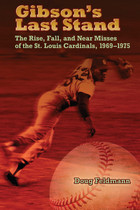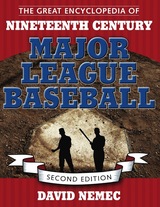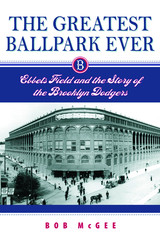128 books about Baseball and 3
start with G
128 books about Baseball and 3
128 books about Baseball
3 start with G start with G
3 start with G start with G

Gibson's Last Stand
The Rise, Fall, and Near Misses of the St. Louis Cardinals, 1969-1975
Doug Feldmann
University of Missouri Press
During star-pitcher Bob Gibson’s most brilliant season, the turbulent summer of 1968, he started thirty-four games and pitched every inning in twenty-eight of them, shutting out the opponents in almost half of those complete games. After their record-breaking season, Gibson and his teammates were stunned to lose the 1968 World Series to the Detroit Tigers. For the next six years, as Bob Gibson struggled to maintain his pitching excellence at the end of his career, changes in American culture ultimately changed the St. Louis Cardinals and the business and pastime of baseball itself.
Set against the backdrop of American history and popular culture, from the protests of the Vietnam War to the breakup of the Beatles, the story of the Cardinals takes on new meaning as another aspect of the changes happening at that time. In the late 1960s, exorbitant salaries and free agency was threatening to change America’s game forever and negatively impact the smaller-market teams in Major League Baseball. As the Cardinals’ owner August A. Busch Jr. and manager Albert “Red” Schoendienst attempted to reinvent the team, restore its cohesiveness, and bring new blood in to propel the team back to contention for the pennant, Gibson remained the one constant on the team.
In looking back on his career, Gibson mourned the end of the Golden Era of baseball and believed that the changes in the game would be partially blamed on him, as his pitching success caused team owners to believe that cash-paying customers only wanted base hits and home runs. Yet, he contended, the shrinking of the strike zone, the lowering of the mound, and the softening of the traditional rancor between the hitter and pitcher forever changed the role of the pitcher in the game and created a more politically correct version of the sport.
Throughout Gibson’s Last Stand, Doug Feldmann captivates readers with the action of the game, both on and off the field, and interjects interesting and detailed tidbits on players’ backgrounds that often tie them to famous players of the past, current stars, and well-known contemporary places. Feldmann also entwines the teams history with Missouri history: President Truman and the funeral procession for President Eisenhower through St. Louis; Missouri sports legends Dizzy Dean, Mark McGwire, and Stan “the Man” Musial; and legendary announcers Harry Caray and Jack Buck. Additionally, a helpful appendix provides National League East standings from 1969 to 1975.
Bob Gibson remains one of the most unique, complex, and beloved players in Cardinals history. In this story of one of the least examined parts of his career—his final years on the team—Feldmann takes readers into the heart of his complexity and the changes that swirled around him.
[more]

The Great Encyclopedia of Nineteenth-Century Major League Baseball
David Nemec
University of Alabama Press, 2006
The authoritative compendium of facts, statistics, photographs, and analysis that defines baseball in its formative first decades
This comprehensive reference work covers the early years of major league baseball from the first game—May 4, 1871, a 2-0 victory for the Fort Wayne Kekiongas over the visiting Cleveland Forest City team—through the 1900 season. Baseball historian David Nemec presents complete team rosters and detailed player, manager, and umpire information, with a wealth of statistics to warm a fan’s heart.
Sidebars cover a variety of topics, from oddities—the team that had the best record but finished second—to analyses of why Cleveland didn’t win any pennants in the 1890s. Additional benefits include dozens of rare illustrations and narrative accounts of each year’s pennant race. Nemec also carefully charts the rule changes from year to year as the game developed by fits and starts to formulate the modern rules. The result is an essential work of reference and at the same time a treasury of baseball history.
This new edition adds much material unearthed since the first edition, fills gaps, and corrects errors, while presenting a number of new stories and fascinating details. David Nemec began the lifetime labor that helped produced this work in 1954 and admits it may never end, as there always will be some obscure player whose birth date has not yet been found. Until perfection is achieved, this work offers state-of-the-art accuracy and detail beyond that supplied by even modern baseball encyclopedias. As Casey Stengel, who was born during this era, was wont to say, “you could look it up.” Now you can.
[more]

The Greatest Ballpark Ever
Ebbets Field and the Story of the Brooklyn Dodgers
McGee, Bob
Rutgers University Press, 2005
Generations after its demise, Ebbets Field remains the single most colorful and enduring image of a baseball park, with a treasured niche in the game's legacy and the American imagination.
In this lively story of sports, politics, and the talented, hilarious, and charming characters associated with the Brooklyn Dodgers, Bob McGee chronicles the ballpark's vibrant history from the drawing board to the wrecking ball, beginning with Charley Ebbets and the heralded opening in 1913, on through the eras that followed. McGee weaves a story about how Ebbets Field's architectural details, notable flaws, and striking facade brought Brooklyn and its team together in ways that allowed each to define the other.
Drawing on original interviews and letters, as well as published and archival sources, The Greatest Ballpark Ever explores the struggle of Charley Ebbets to build Ebbets Field, the days of Wilbert Robinson's early pennant winners, the eras of the Daffiness Boys, Larry MacPhail, and Branch Rickey, the tumultuous field leadership of Leo the Lip, the fiery triumph of Jackie Robinson, the golden days of the Boys of Summer, and Walter O'Malley's ignominious departure.
With humor and passion, The Greatest Ballpark Ever lets readers relive a day in the raucous ballpark with its quirky angles and its bent right-field wall, with the characters and events that have become part of the nation's folklore.
In this lively story of sports, politics, and the talented, hilarious, and charming characters associated with the Brooklyn Dodgers, Bob McGee chronicles the ballpark's vibrant history from the drawing board to the wrecking ball, beginning with Charley Ebbets and the heralded opening in 1913, on through the eras that followed. McGee weaves a story about how Ebbets Field's architectural details, notable flaws, and striking facade brought Brooklyn and its team together in ways that allowed each to define the other.
Drawing on original interviews and letters, as well as published and archival sources, The Greatest Ballpark Ever explores the struggle of Charley Ebbets to build Ebbets Field, the days of Wilbert Robinson's early pennant winners, the eras of the Daffiness Boys, Larry MacPhail, and Branch Rickey, the tumultuous field leadership of Leo the Lip, the fiery triumph of Jackie Robinson, the golden days of the Boys of Summer, and Walter O'Malley's ignominious departure.
With humor and passion, The Greatest Ballpark Ever lets readers relive a day in the raucous ballpark with its quirky angles and its bent right-field wall, with the characters and events that have become part of the nation's folklore.
[more]
READERS
Browse our collection.
PUBLISHERS
See BiblioVault's publisher services.
STUDENT SERVICES
Files for college accessibility offices.
UChicago Accessibility Resources
home | accessibility | search | about | contact us
BiblioVault ® 2001 - 2024
The University of Chicago Press









